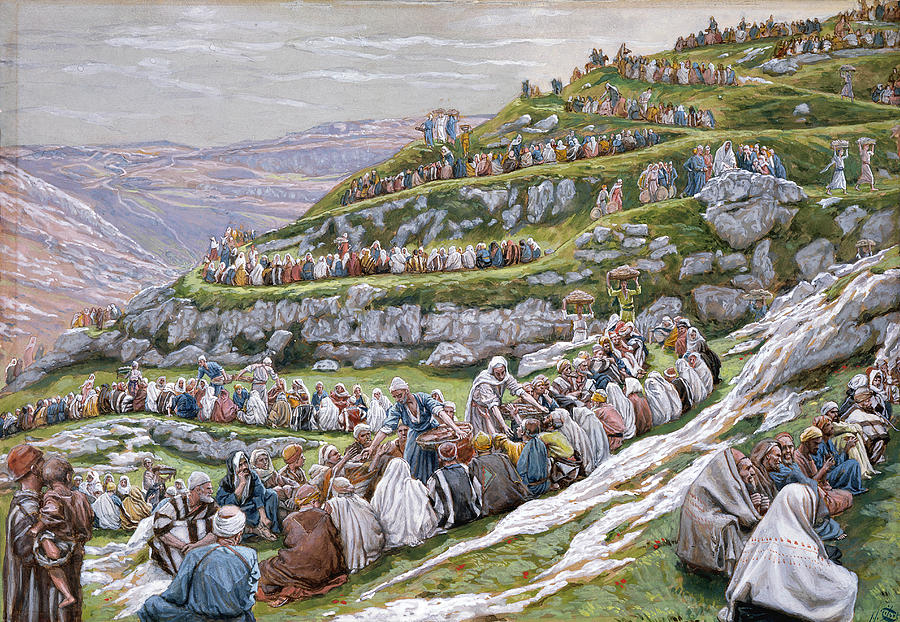

March 14
lent 4
Jesus Feeds the Five Thousand
6 After this Jesus went away to the other side of the Sea of Galilee, which is the Sea of Tiberias. 2 And a large crowd was following him, because they saw the signs that he was doing on the sick. 3 Jesus went up on the mountain, and there he sat down with his disciples. 4 Now the Passover, the feast of the Jews, was at hand. 5 Lifting up his eyes, then, and seeing that a large crowd was coming toward him, Jesus said to Philip, “Where are we to buy bread, so that these people may eat?” 6 He said this to test him, for he himself knew what he would do. 7 Philip answered him, “Two hundred denarii[a] worth of bread would not be enough for each of them to get a little.” 8 One of his disciples, Andrew, Simon Peter’s brother, said to him, 9 “There is a boy here who has five barley loaves and two fish, but what are they for so many?” 10 Jesus said, “Have the people sit down.” Now there was much grass in the place. So the men sat down, about five thousand in number. 11 Jesus then took the loaves, and when he had given thanks, he distributed them to those who were seated. So also the fish, as much as they wanted. 12 And when they had eaten their fill, he told his disciples, “Gather up the leftover fragments, that nothing may be lost.” 13 So they gathered them up and filled twelve baskets with fragments from the five barley loaves left by those who had eaten. 14 When the people saw the sign that he had done, they said, “This is indeed the Prophet who is to come into the world!”
15 Perceiving then that they were about to come and take him by force to make him king, Jesus withdrew again to the mountain by himself.
The gospel according to john
John 6:1-15
- Write out the events of this passage in your own words. What attributes of God’s character are evident in this passage?
- Why do you think Jesus asks Philip where they could buy bread for so many people? He knew what he was going to do.
- Is there a situation in your life where there is an impossible gap? Write out the details.
Are there any “fish or loaves” in your situation? Is there some kind of provision that seems too small to meet the need? Give thanks for this provision as Jesus gave thanks for the loaves and fish.
Write a prayer asking for what you need. We do not know how God will intervene, but we know that He is good and able to provide abundantly more than we could ask or imagine.
End your time in this passage by offering three sentences of worship to God. As a starting point, you could use the attributes of his character you listed above in question two.

visio divina
The Miracle of the Loaves and Fishes by James Tissot, circa 1886-1896, Opaque watercolor over graphite on gray wove paper, 7 ⅜” x 10 9/16” / Brooklyn Museum, Brooklyn.
What are you most drawn to in this image?
How are your emotions stirred by it?
Ask the Lord to increase your holy desires.
Tissot renders this almost modern panoramic view so large and encompassing that it’s difficult to distinguish Jesus himself. Hint: look to the upper right. As Jesus’ teachings and news of his deeds spread, his followers increased in number. Notice the vast use of space, and how the crowd sprawls beyond the bounds of the painting. It’s almost hard to see the miracle that’s occurring! As you observe the artist’s composition emphasizing the multitude as they experience the miracle, what feelings arise?
Imagine you are a god-fearing Israelite. You have heard many false prophets proclaiming that they are the Messiah. But today you catch word of an itinerant preacher from Galilee teaching life-changing messages nearby. Your neighbors tell of miracles and hope.
You quickly gather your spouse, children, aunties, and uncles, and run to the hillside where Jesus is preaching. His words mesmerize you. He is different from the other so-called anointed ones.
After a while, you can’t ignore your stomach’s loud rumbles and the children clamoring for food. Thousands around you are gathered, far from home and hungry. In the distance, the preacher, Jesus, gathers five loaves and two fish from a young boy. After giving thanks to Yahweh, he distributes the baskets of food himself, feeding all who are hungry. Notice how in this artist’s composition, some are watching Jesus and others are not. Do you notice Jesus’s miraculous provision, or do you imagine yourself distracted by your hunger and the noise?
Lastly, imagine your fellow countrymen murmuring, “This is indeed the Prophet who is to come into the world!” (John 6:14).
Are any earthly “hungers” currently pressing on your mind, perhaps distracting you from your relationship with Jesus? Sit before the Lord and have a little conversation about whatever arises in your heart.
Settling and Noticing (eyes open) – 2 minutes
- Take a few deep breaths. Settle into this present moment. Open your heart to God.
- Explore all of the details, colors, movements, and shapes in the image. Then focus more intently on a single aspect of the larger image.
Savoring and Pondering (eyes closed) – 1 minute
- Staying with the part of the image you are drawn to, close your eyes, and recreate or visualize that aspect of the image in your mind’s eye.
- While your eyes are still closed, notice any images, feelings, thoughts or memories from your life that might arise in association with this image
Conclusion (eyes opened or closed) – 2 minutes
- How does the image and your response to it meet you at this particular moment of your life?
- Have a little conversation with God about whatever has arisen in your heart during this exercise. You might find it helpful to write down what happened as you prayed with this image.
Musical Devotion
Worship
Teach Us Your Ways (The Porter's Gate)
Classical
Cantata: Es wartet alles auf dich, BWV 187 (J.S. Bach)
